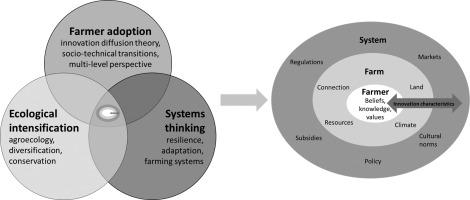Agricultural Systems ( IF 6.1 ) Pub Date : 2021-04-03 , DOI: 10.1016/j.agsy.2021.103142 Maria Kernecker , Verena Seufert , Mollie Chapman

|
CONTEXT
Ecological intensification (EI) describes farming practices that aim to use ecological processes for producing agricultural yields. While evidence for the ecological benefits of EI is plentiful, the question of how it can be more widely adopted by farmers, and why it has not been so far, remains pertinent, since only approximately 9% of the globally farmed land is currently managed with EI practices. We suggest that considering farmers as central while attending to farm and system level factors can help to identify barriers and facilitators to EI adoption. To do this, we look to diverse, overlapping bodies of literature encompassing EI practice details, systems thinking, and farmer adoption. Innovation characteristics is one framework that has been used to study farmer adoption of new farm management tools and practices.
OBJECTIVE
Our objective is to use innovation characteristics for identifying farmer, farm, and system level barriers and potential solutions to EI adoption. We then aim to synthesize broader lessons for a sustainability transition in agriculture.
METHODS
We treat EI as a suite of innovations, including practices, technologies, and knowledge. We explore how the innovation characteristics of EI - i.e. their relative advantage, compatibility, complexity, trialability and observability – manifest at each of three levels: farmer, farm, and system. We apply our approach to three case studies of EI adoption from different world regions: 1) managing landscape complexity in Germany, 2) installation of riparian buffers in the USA and 3) organic farming in India.
RESULTS AND CONCLUSIONS
An analysis of our case studies using innovation characteristics helped identify barriers to EI adoption and at what level these barriers should be addressed. Barriers included: uncoupled financial and farm-level ecological relative advantages of EI (system level), framing that is not in line with farm values and needs (farmer level), insufficient training for managing complex systems (farmer level), and time constraints for experimentation with and observation of EI effects (farm level). System level solutions could support training and experimentation with EI, empowering farmers by providing them with autonomy to adapt and apply EI as they see fitting.
SIGNIFICANCE
Using innovation characteristics and diverse bodies of knowledge allowed us to identify barriers, but also opportunities at farmer, farm, and system level. Abundant work focuses on convincing farmers of what science says is right, so showing farmers that barriers are not explicit to them is a helpful step forward in the transition towards sustainability.
中文翻译:

以农民为中心的生态集约化:利用创新特征确定农业生态系统向可持续发展过渡的障碍和机遇
语境
生态集约化(EI)描述了旨在利用生态过程来生产农业产量的农业实践。尽管有大量证据表明EI的生态效益,但有关如何使其在农民中更广泛采用以及为何至今仍未得到解决的问题仍然存在,因为目前仅约9%的全球耕地已通过EI进行管理。 EI实践。我们建议在考虑农场主和系统级因素的同时,以农民为中心,可以帮助您确定实施EI的障碍和促进者。为此,我们寻求涵盖EI实践细节,系统思维和农民采用的多样化,重叠的文献体系。创新特征是一种框架,用于研究农民对新农场管理工具和实践的采用。
客观的
我们的目标是利用创新特征来识别农民,农场和系统级的障碍以及采用EI的潜在解决方案。然后,我们旨在综合更广泛的经验教训,以实现农业的可持续性转型。
方法
我们将EI视为一整套创新,包括实践,技术和知识。我们探索EI的创新特征,即它们的相对优势,兼容性,复杂性,可试用性和可观察性,如何在三个层次上分别体现:农民,农场和系统。我们将我们的方法应用于来自世界不同地区的EI的三个案例研究:1)在德国管理景观的复杂性,2)在美国安装河岸缓冲带,以及3)在印度进行有机农业。
结果与结论
使用创新特征对我们的案例研究进行分析有助于确定采用EI的障碍,以及应在哪些级别上解决这些障碍。障碍包括:EI的财务和农场级生态相对优势脱钩(系统级),与农场价值和需求不符的框架(农民级),管理复杂系统的培训不足(农民级)以及农业生产的时间限制实验和观察EI效应(农场水平)。系统级解决方案可以支持EI的培训和实验,通过为农民提供自主权,使其适应和应用EI的能力,从而赋予农民权力。
意义
利用创新特征和多样化的知识体系,我们可以确定障碍,也可以发现农民,农场和系统级的机会。大量的工作着眼于说服农民说科学是正确的,因此向农民表明障碍对他们而言并不明显,这是向可持续发展过渡的有益一步。











































 京公网安备 11010802027423号
京公网安备 11010802027423号